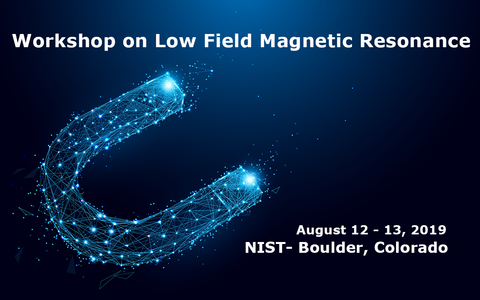
This workshop will focus on developments in low field magnetic resonance. Developments include but are not limited to magnetic resonance imaging/spectroscopy, electron paramagnetic resonance spectroscopy/imaging, single sided magnet designs, and applications in industry such as oil rock/well analysis and medical/clinical applications.
Workshop goals:
- Find a consensus on the state of low-field magnetic resonance
- Develop a roadmap for low-field magnetic resonance progress
- Identify scientific areas where low-field can have the greatest impact
- Identify barriers to progress that must be overcome to reach full adoption of low-field MR into the clinic and how NIST can aid in addressing these
Agenda (Printable PDF) Updated 8/5
There will be informal events in the afternoon on Sunday, August 11, 2019.
Day 1 – August 12, 2019
|
7:30 |
Breakfast Opportunity to upload presentations
|
|
8:30 |
Opening Karl Stupic, National Institute of Standards and Technology
|
|
8:45 |
Welcome Walter Copan, Under Secretary of Commerce for Standards and Technology, Director of National Institute of Standards and Technology
|
|
9:00 |
Unusual applications of NMR Eiichi Fukushima, ABQMR
|
|
9:30 |
Session A: “So, where are we at?”: Current State of Low Field MR Moderator: Scott Hinks, GE Healthcare Artificial Intelligence Image Reconstruction for Low-field MRI Neha Koonjoo, Athinoula A. Martinos Center for Biomedical Imaging Clinically Feasible Magnetic Resonance Fingerprinting at Low Field Strengths Mark Griswold, Case Western Reserve University MRI at Low Field in the Inhomogeneous Magnetic Field Boguslaw Tomanek, University of Alberta Low field EPR: CW, Pulse, or Rapid Scan? Gareth R. Eaton, University of Denver Sandra S. Eaton, University of Denver
|
|
10:50 |
Break
|
|
11:00
|
Session B: “What do I need to make this work?”: Hardware for Low Field MR Moderator: Joshua Biller, TDA Research Human-scale Fast Field-Cycling MRI at the University of Aberdeen David Lurie, University of Aberdeen B0 magnets based on permanent magnet arrays for portable, low-cost, and low-field brain MRI Patrick McDaniel, Athinoula A. Martinos Center for Biomedical Imaging The Recent research progress of a low-field permanent-magnet-based MRI Head Imager in Singapore University of Technology and Design Shaoying Huang, Singapore University of Technology and Design Low-Field MRI Lab at VUIIS William Grissom, Vanderbilt University
|
|
|
|
|
Noon |
Lunch
|
|
13:30 |
Session C: “What can you accomplish with just one side?”: Single Sided Low Field MR Moderator: Clarissa Cooley, Athinoula A. Martinos Center for Biomedical Imaging The Three Magnet Array for Single Sided Magnet Magnetic Resonance Bruce Balcom, University of New Brunswick RF Coil and Signal Processing Improvements for Unilateral NMR Daniel Gruber, University of California, Davis Sophia Fricke, University of California, Davis Relax Locally: Leveraging field gradients to improve data acquisition and probe spatially heterogeneous chemical processes Tyler Meldrum, William and Mary Fluid volume status monitoring via portable, single-sided magnet resonance Christopher Frangieh, Massachusetts Institute of Technology
|
|
14:50 |
Break
|
|
14:15 |
Session D: “Bringing the magnet to the people”: Low Field MR for Point of Care Moderator: Michelle Macpherson, Synaptive Medical Compositional Imaging of the Breast and Mammographic Density Assessment Using Portable Single-Sided NMR Konstantin Momot, Queensland University of Technology Compact NMR for Metabolic Health Screening and Diabetes Prevention David Cistola, Texas Tech University Health Sciences Center The Potential for Diagnostic Cardiovascular MR at Low Field Orlando Simonetti, The Ohio State University Low-field MRI as a diagnostic tool for the treatment of hydrocephalus in Africa Joshua Harper, Pennsylvania State University Office based MRI for prostate imaging: a healthcare economics perspective Dinesh Kumar, Promaxo
|
|
16:50 |
Day 1 Wrap Up
|
|
17:30 |
Day 1 End Unofficial Dinner: Martin Park @ 18:00, details at workshop
|
|
|
|
A room block has been arranged at the Best Western Plus Boulder Inn - 770 28th Street, Boulder, CO 80303
• online code: https://www.bestwestern.com/en_US/book/hotel-rooms.06103.html?groupId=6L0QH0F5
• Group code: call 800-233-8469 and reference code " NIST Low Field Magnetic Resonance "
• Group Rates: $174 for a room with one king bed (Book by July 11, 2019)
If you are not registered, you will not be allowed on site. Registered attendees will receive security and campus instructions prior to the workshop.
NON U.S. CITIZENS PLEASE NOTE: All foreign national visitors who do not have permanent resident status and who wish to register for the above meeting must supply additional information. Failure to provide this information prior to arrival will result, at a minimum, in significant delays in entering the facility. Authority to gather this information is derived from United States Department of Commerce Department Administrative Order (DAO) number 207-12.
NIST currently accepts the following forms of federally issued identification in lieu of a state-issued driver's license, such as a valid passport, passport card, DOD's Common Access Card (CAC), Veterans ID, Federal Agency HSPD-12 IDs, Military Dependents ID, Transportation Workers Identification Credential (TWIC), and TSA Trusted Traveler ID.
U.S. Residents: New Visitor Access Requirement: Effective July 21, 2014, under the REAL ID Act of 2005, agencies, including NIST, can only accept a state-issued driver's license or identification card from states that are REAL ID compliant or have an extension. See the Department of Homeland Security (DHS) site for the current compliance list

